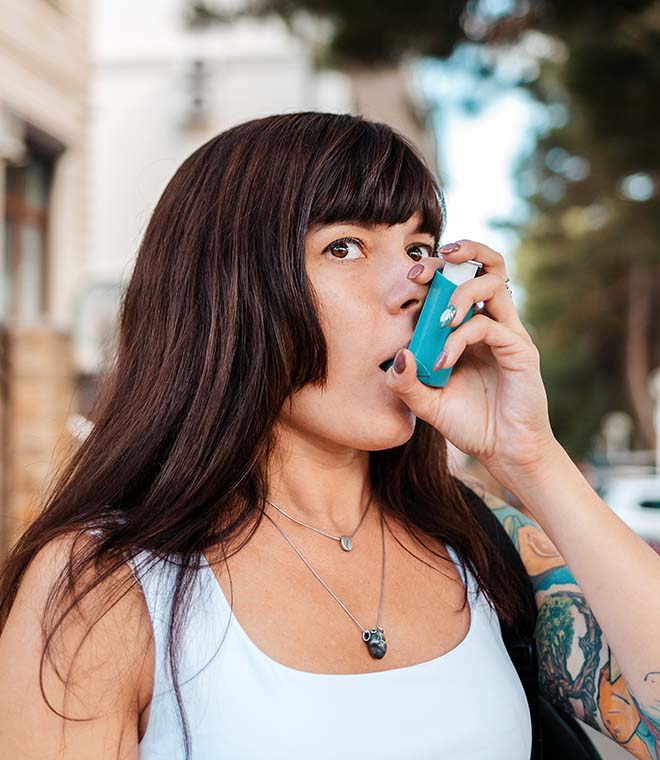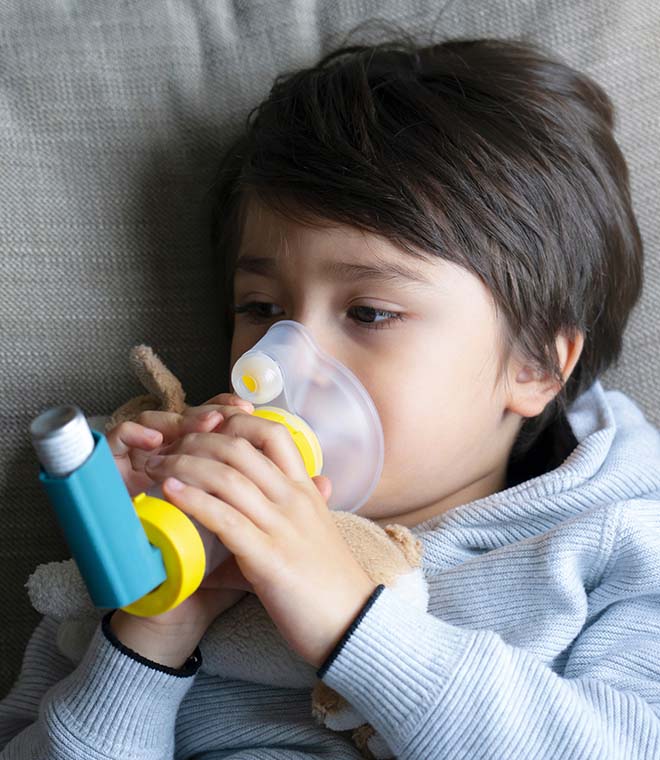Health
Types of asthma inhalers
Andy Stergachis, PhD, BPharm Feb 10, 2021 • 8 min
Asthma is a chronic disease affecting the airways of the lungs.
People with asthma commonly experience wheezing, breathlessness, chest tightness and coughing. Some people may have daily asthma symptoms. Others may only have asthma during exercise. The onset of asthma can be triggered by exposure to tobacco smoke, dust mites or infections like colds. An asthma attack can cause coughing, wheezing and breathing trouble. Recognizing and immediately treating the symptoms of an asthma attack is important. Equally important is controlling asthma to prevent asthma attacks.
Asthma can affect physical health and quality of life. The main goals of asthma management are to control asthma symptoms and reduce the risk of asthma attacks, while minimizing side effects from medications. Most people living with asthma can control their symptoms and prevent asthma attacks by avoiding asthma triggers and correctly using prescribed medicines.
The importance of inhalers
Asthma inhalers are the most common and effective way to deliver medicine directly to the lungs. Proper technique is important for inhalers to correctly deliver medication to the lungs. Poor asthma symptom control is often due to incorrect inhaler technique. It’s estimated that most people do not use their inhalers properly. If you use an inhaler, it’s important for your healthcare provider to check your technique and make corrections as necessary.
There are several different types of asthma inhalers. These include short-acting reliever inhalers and long-acting controller inhalers. Having the right inhaler and using it correctly can help deliver the medication needed to prevent or treat asthma attacks.
Reliever medication inhalers
Reliever inhalers are used to reduce the symptoms of an asthma attack. A reliever inhaler delivers a type of medicine called a bronchodilator that helps open your airways, making it easier to breathe. Bronchodilators also help clear mucus from the lungs so that it can be coughed up. Short-acting or quick-relief inhalers provide relief from symptoms. Once inhaled, the medicine from a short-acting reliever inhaler can last for two to four hours. Reliever inhalers can also be prescribed for use before exercise to prevent asthma symptoms for people with exercise-induced asthma.
If you’re using a rescue inhaler more than two days a week, tell your healthcare provider. Increasing use of a short-acting reliever inhaler or using a short-acting reliever inhaler more than two days a week for symptom relief generally indicates poor control of asthma and the need for starting or increasing anti-inflammatory therapy.
Prescription-only short-acting reliever inhalers include albuterol (available as a generic and as these brand-name products: ProAir HFA, Proventil HFA and Ventolin HFA) and levalbuterol (Xopenex HFA). Albuterol inhalers contain 200 metered doses, meaning each inhalation provides a consistent dose of the medication. Most metered-dose inhalers have a dose counter that keeps track of the number of puffs each time you press the inhaler. Short-acting rescue inhalers push out a short puff of medication from a small aerosol canister through a plastic mouthpiece.
Primatene Mist is a short-acting rescue inhaler that is available without a prescription. Primatene Mist is intended to provide temporary relief for symptoms of mild, intermittent asthma. The active ingredient in Primatene Mist is a bronchodilator called epinephrine. Primatene Mist is FDA approved only for those who have been diagnosed with asthma by a healthcare provider. However, national guidelines for managing asthma recommend against the use of inhaled epinephrine for the treatment of asthma.
Bronchodilators can have side effects such as a nervous or shaky feeling, faster heart rate or palpitations.
Long-term control inhalers
These types of inhalers are used regularly on a long-term basis to control symptoms and prevent asthma attacks. Long-term control medications are an important treatment for most people with asthma. Long-term control medications include inhaled corticosteroids and inhaled long-acting bronchodilators.
Inhaled corticosteroids
Your healthcare provider may prescribe inhaled corticosteroids to reduce inflammation in the lungs. Inflammation plays a major role in asthma, causing swelling and mucus production in the airways of someone with asthma. Inhaled corticosteroids have been shown to reduce the frequency of asthma attacks, decrease the need for reliever inhalers, improve lung function and even reduce emergency room visits and hospitalizations for life-threatening asthma. Inhaled corticosteroid inhalers include beclomethasone (Qvar RediHaler), budesonide (Pulmicort Flexhaler), ciclesonide (Alvesco), fluticasone (Flovent HFA), and mometasone (Asmanex Twisthaler).
Inhaled corticosteroids can cause mild side effects, such as thrush infections (a yeast infection in the mouth, throat or esophagus) and a sore throat, although these are not common. Rinsing the mouth, gargling after using the asthma inhaler, and using a spacer device with metered-dose inhalers can help prevent these side effects. A spacer device is a plastic tube that attaches to the inhaler and holds the medication until you can breathe in the medicine. Younger children may also need a mask along with a spacer for their asthma treatment. Note that young children and babies who can't use inhalers for their asthma treatment may be prescribed a nebulizer. A nebulizer is a device that sprays a fine, liquid mist of medicine.
Long-acting bronchodilators
Long-acting bronchodilator inhalers are used to provide control—not quick relief—of asthma. Long-acting bronchodilator asthma inhalers include salmeterol (Serevent) and tiotropium bromide inhalation spray (SPIRIVA RESPIMAT). Long-acting bronchodilators should only be used as an additional treatment for people who are using an inhaled steroid. Discuss the benefits and risks of long-acting bronchodilators with your health care provider.
Combination inhaled medicines
Combination inhaled medicines include an inhaled corticosteroid combined with a long-acting bronchodilator. Combination inhaled medicines include budesonide/formoterol (Symbicort), mometasone/formoterol (Dulera), fluticasone/salmeterol (Advair), and fluticasone furoate/vilanterol (Breo Ellipta).
Most people with asthma can lead full lives and are able to control their symptoms and prevent asthma attacks by learning how to avoid asthma triggers and taking their medicines as prescribed. Talk to your healthcare provider if you have concerns or questions.
Published February 2021.
Sources
1. https://www.cdc.gov/vitalsigns/asthma/index.html
2. https://www.nhlbi.nih.gov/health-topics/all-publications-and-resources/2020-focused-updates-asthma-management-guidelines
3. https://www.mayoclinic.org/diseases-conditions/asthma/in-depth/asthma-medications/art-20045557
4. https://www.aafa.org/asthma-treatment
5. https://www.mayoclinic.org/diseases-conditions/asthma/in-depth/asthma-inhalers/art-20046382
6. https://medlineplus.gov/druginfo/meds/a682145.html
7. https://www.webmd.com/asthma/guide/asthma-control-with-anti-inflammatory-drugs
8. https://medlineplus.gov/ency/patientinstructions/000042.htm
9. https://www.nationaljewish.org/conditions/pediatric-asthma/overview/treatment/inhaled-asthma-medications-inhalers-nebulizers



